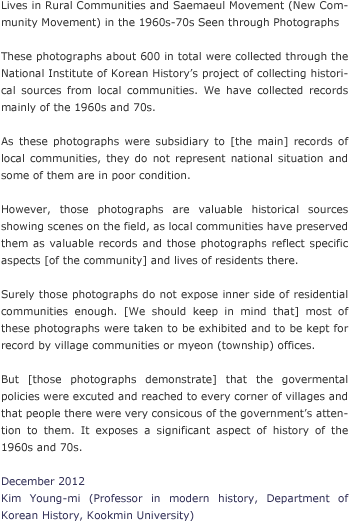Along with the New Village Movement, the government instructed each village to organize a womens’ group to effectively mobilize women. Teaching materials for the New Village Movement were distributed to the womens’ groups and womens’ group leaders were educated, with prizes for the best examples. The womens’ groups began with work like anti-drinking campaigns, campaigns to save rice and money, collecting waste articles, joint running of shops, daycare for children, communal cooking, and communal cultivation.
-
 Cooking after communal work
Cooking after communal work
Photograph owned by Yi Taebaek, of Pyeong-dong (town), Gwangsan-gu (borough), Gwangju (city). 1974. A scene of shared meal preparation after communal labor at the peak of the New Village Movement. Looking at the clothing and headscarves of the women, this is from a village where there had been lifestyle improvement campaigns (Saenghwal Gaeseon Undong) for cooking and hygiene, or the women were especially careful with their clothes in front of the camera.
-
 Saving rice and money in Maechon-dong, Ssangnim-myeon, Goryeong-gun
Saving rice and money in Maechon-dong, Ssangnim-myeon, Goryeong-gun
In this picture the members of the New Village womens’ group in Maechon-dong, Ssangnim-myeon, Goryeong-gun, Gyeongsangbuk-do, have collected rice, brought it in rice-saving pots (Jeolmi Hangari), and are waiting to make a deposit. When cooking rice for mealtimes, women saved a little rice and collected it in the pot to be deposited once a month. Each woman had an account at the womens’ group and for many women the money saved in these accounts became a useful source of cash that could not be touched by their husbands or families. Because women felt that this rice saving campaign provided them with some money, however little, there were many positive responses to the campaign. Photograph owned by Ssangnim-myeon Town Hall, Goryeong-gun. 1969.
-
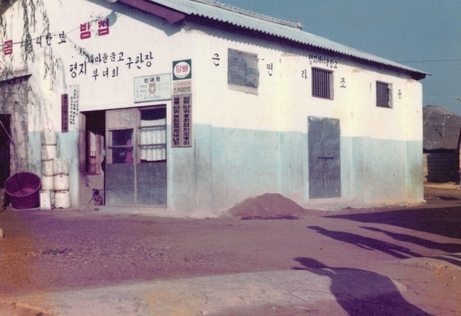 Pyeongji New Village fund and womens’ group shop.
Pyeongji New Village fund and womens’ group shop.
Running a shop was a typical enterprise among womens’ groups. In villages which were far from markets, money could be saved on transportation if farmers used a shop supplied with everyday items, and womens’ groups also made a little profit through these shops which could be saved as a fund for the womens’ group. The products on sale were consumer goods such as matches, soap, sugar, ramen, etc. Personal photograph from Pyeong-dong, Gwangsan-gu, Gwangju. 1976.
-
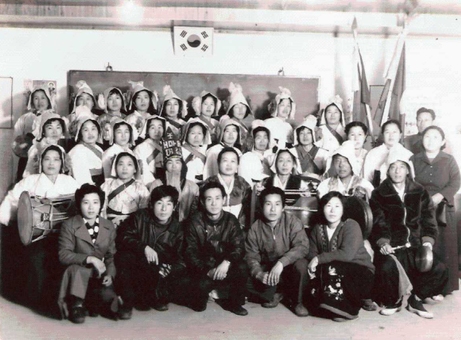 A womens’ traditional farming music (Nongak) troupe raising funds for New Village projects
A womens’ traditional farming music (Nongak) troupe raising funds for New Village projects
Commemorative photo of the women’s group traditional farming music (Nongak) troupe in Sangju-ri (village) Sangju-myeon (town), Namhae-gun (county). The women’s group formed a traditional farming music band and collected 503,000 won for funds for the New Village work on the 15th day of the new lunar year (Jeong-wol Daeboreum). Photograph owned by Sangju-ri Village Hall, Sangju-myeon, Namhae-gun, Gyeongsangnam-do (province).
-
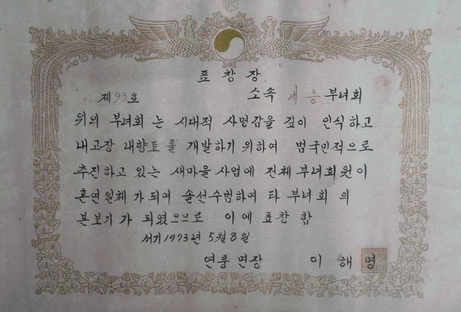 Award certificate to the womens’ group
Award certificate to the womens’ group
Certificate praising the activities of the womens’ group in Naeeung-ri (village) Yeonpung-myeon (town), Goesan-gun (county), Chungcheongbuk-do (province), awarded by the Town Mayor of Yeonpung myeon. Surrounded in a patriarchal system, the women called upon and encouraged by the state gladly became actors in the New Village Movement. The New Village Movement was a system for the state to mobilize women, but it a considerable part was also rooted in the motivation of women. Women freed themselves from a patriarchal system taking the state’s demands as an opportunity. Personal photograph from Yeonpung-myeon, Goesan-gun, Chungcheongbuk-do. 1973.
-
 A daycare during the peak agricultural season in Maechon-dong
A daycare during the peak agricultural season in Maechon-dong
In order for women to work, this had to be accompanied by communal care for children. Because of this, in the 1960s and 1970s many nurseries operated in rural villages during the agricultural busy season. This is one such nursery in Maechon-dong, Ssangnim-myeon, Goryeong-gun. The poster notes that the nursery runs “from June 16th to July 5th”. Photograph owned by Ssangnim myeon Town Hall, Goryeong-gun.
-
 Daycare in Maechon-dong (1)
Daycare in Maechon-dong (1)
Sign reads “Maechon Bugang Village Daycare”. Looking at the swing and slide, it appears that the daycare was run from the village kindergarten or school. Photograph owned by Ssangnim myeon Town Hall, Goryeong-gun. 1969.
-
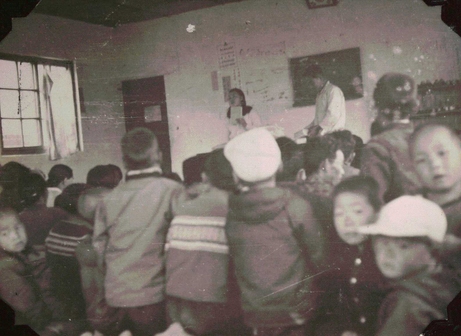 Daycare in Maechon-dong (2)
Daycare in Maechon-dong (2)
These children are slightly older. Rather than a nursery, this is more of an after school club. Photograph owned by Ssangnim myeon Town Hall, Goryeong-gun. 1969.
-
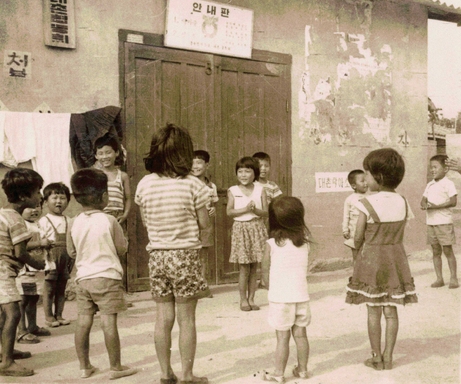 Education at Daechon nursery
Education at Daechon nursery
Scene of a nursery during the agricultural busy season in Daechon-dong (town), Buk-gu (borough), Gwangju (city). It appears to be a staged photograph, but the childrens’ faces are bright. Private photograph from Donggok-dong (town), Gwangsan-gu (borough), Gwangju. 1981.
-
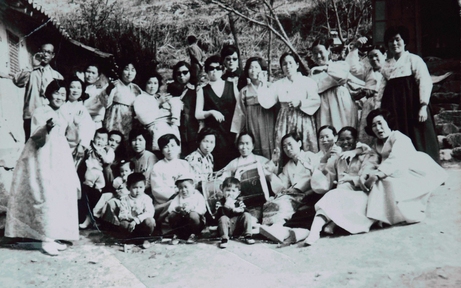 Womens’ groups get together from Pallang 1(il)-ri and Pallang 2(i)-ri (village)
Womens’ groups get together from Pallang 1(il)-ri and Pallang 2(i)-ri (village)
Sightseeing was actively encouraged as a way to use part of the funds collected by womens’ groups. Women’s group sightseeing trips were popular among women from rural villages who did not usually find it easy to leave the house. This is a commemorative photograph of the meeting between womens’ groups from Pallang 1(il)-ri and Pallang 2(i)-ri (village). It is unusual to see women wearing sunglasses. Photograph owned by Ko Sunbok, of Dong-myeon (town), Yanggu-gun (county), Gangwon-do (province). Early 1970s.
-
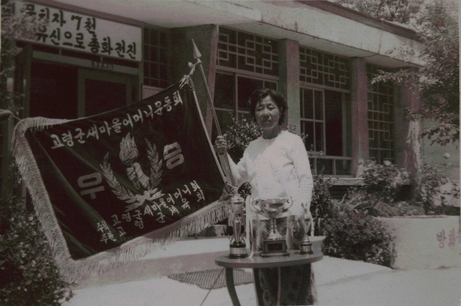 New Village mothers’ sports competition in Goryeong-gun
New Village mothers’ sports competition in Goryeong-gun
Sports competition among the New Village mothers’ groups gathered in Goryeong-gun. Photograph owned by New Village branch office, Goryeong-gun. 1970s.
-
 New Village mothers’ sports competition in Goryeong-gun
New Village mothers’ sports competition in Goryeong-gun
Photograph owned by New Village branch office, Goryeong-gun. 1970s.
-
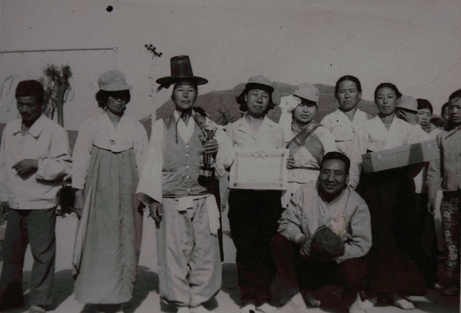 With certificates at the New Village mothers’ sports competition in Goryeong-gun (3)
With certificates at the New Village mothers’ sports competition in Goryeong-gun (3)
Photograph owned by New Village branch office, Goryeong-gun. 1970s.
-
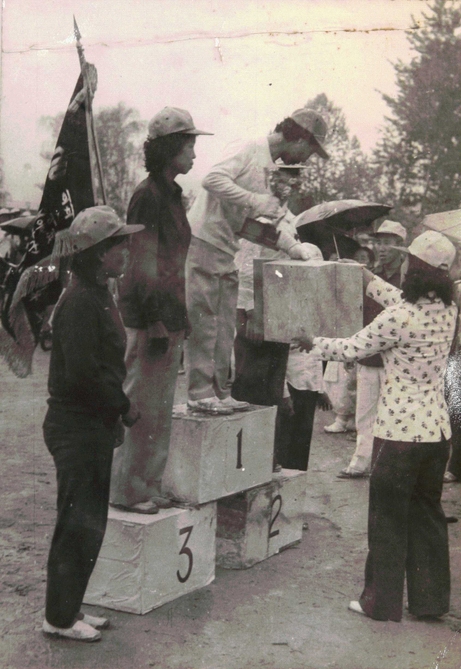 New Village mothers’ sports competition in Goryeong-gun (4)
New Village mothers’ sports competition in Goryeong-gun (4)
Photograph owned by New Village branch office, Goryeong-gun. 1970s.













